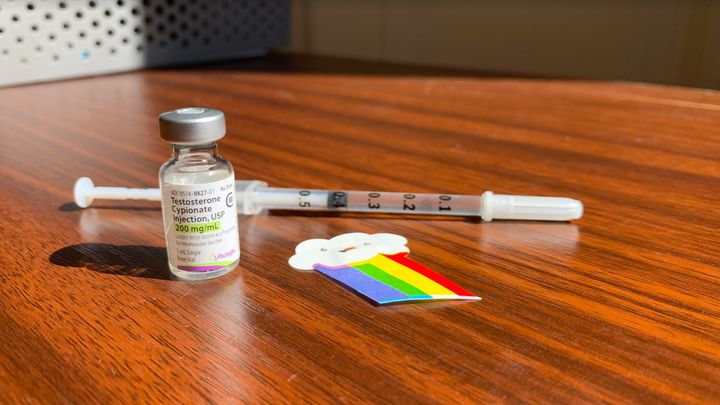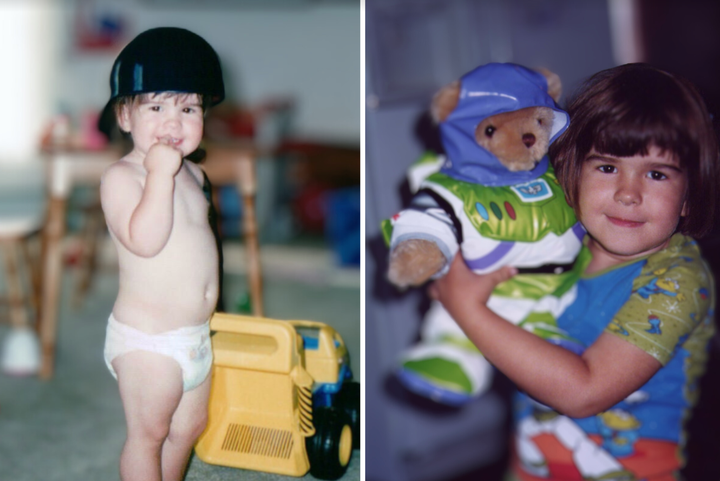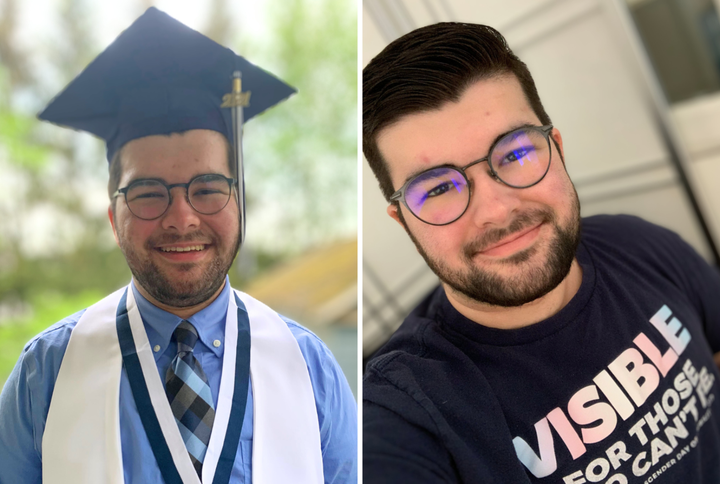
Read. Initial.
Read. Initial.
Read. Initial.
Read. Sign.
Six pages of information about the effects of hormone replacement therapy acknowledged and endorsed by 17-year-old me. It was early 2017, and by that point, it’d been nearly a year since I first came out to my family as transgender. As I sat in the clinic exam room looking through the informed consent document with my mom and doctor, I felt both relief and mounting anticipation that the start of my medical transition was within reach.
What I didn’t know at the time was that between prolonged back-and-forths with insurance companies, issues with my initial bloodwork, and lengthy wait times for gender-related appointments at the children’s hospital, it would still be another two months before I would actually be able to inject myself with my first dose of testosterone.
It’s details like these that are rarely brought up in conversations about gender-affirming care today. Much more common are sensationalised tales of young trans kids being “mutilated” and “groomed” by influential adults in their lives — or of rampant regret and detransitioning later in life.
In fact, Republican lawmakers in more than 20 U.S. states, oftentimes using rhetoric like this, have passed a host of legislation over the past two years to restrict or ban gender-affirming health services for trans individuals under the age of 18.
In places like Missouri and Oklahoma, conservative legislators have gone even further, arguing that age restrictions on gender-affirming care should be raised to 25 or 26 — far older than the states’ legal ages of majority.
With many bans on gender-affirming care now in effect and others making their way through the courts, the Human Rights Campaign estimates that over half of transgender youth in the U.S. ages 13 to 17 are at risk of losing access to what organisations like the American Academy of Paediatrics and the American Medical Association have deemed evidence-based, best-practice care.
It was this same care that I first brought up to my parents in the spring of 2016, shortly after coming out to them as trans. More specifically, I told them about hormone replacement therapy and top surgery — a procedure for removing breast tissue and creating a flat, more masculine chest.
Perhaps unsurprisingly, this was a rather tough sell at first. My parents, both loving and open-minded people, were still adjusting to the fact that one of their children was openly transgender. While they were more than willing to let me explore new names, pronouns, hairstyles and clothing options — something that I’m still grateful for today — they were much more reluctant to give the green light for nonreversible, medical forms of gender affirmation.
Far from being coerced or pressured into gender-related health services, I was the one trying to convince the adults in my life that these kinds of care would benefit me. Whether it was sending my parents YouTube videos about the effects of testosterone or writing detailed lists of pros and cons to review with my therapist, I quickly realised that as a teen, there would be elements of my gender transition that were fully beyond my control.
Even once my parents agreed to schedule a visit with my paediatrician in January 2017 to discuss options for gender-affirming health care, I remember being met with blank stares from my physician and the sinking realisation that she was unfamiliar with current guidelines for treating transgender patients. Luckily, fearing that this might be the case, I had done some digging online before the appointment to find locations in the area that specialised in such care for adolescents. This led me to the gender health program at the local children’s hospital, for which my paediatrician was thankfully willing to write me a referral.
Around a month later, my mom and I attended my first appointment at the hospital. The visit started out like most others with a new doctor: stepping on a scale, having my height measured, and having my temperature and blood pressure taken. A while later, a doctor came into the room and introduced herself, sharing that she would be taking the lead on my initial evaluation and any gender-affirming services I might need. Together, we reviewed my family, medical, and mental health history — covering everything from anxiety and depression to exercise-induced asthma and flat feet. We also discussed my gender identity development, all the way back to when I was a child.

I shared that growing up in the early 2000s, despite being a visibly masculine and “tomboyish” child, I hadn’t had the language needed to come out as transgender for most of my life. Though I often expressed that I wasn’t a girl — even as young as 3 or 4 years old — there were not the same resources and awareness around gender diversity in childhood that exist today. Instead, it wasn’t until I hit puberty and began learning more about LGBTQ+ identities that I found the right words to describe the disconnect in mind, body and social role that I had experienced since I was young.
In addition to the past, my new doctor also talked to my mom and me about the future, including my embodiment goals and overall hopes for medical transition. I reiterated my desires for testosterone and top surgery, describing the physical changes I was most looking forward to: a deeper voice, increased body and facial hair, no more menstrual cycles, fat redistribution, muscle growth and a flat chest.
She shared that under the current standards of care published by the World Professional Association for Transgender Health, a phased approach to gender-affirming care was recommended for adolescents and adults alike. In my case, this would mean taking hormones for a minimum of 12 months before I would be considered a candidate for top surgery. Though this was somewhat disappointing, I also knew that most local surgeons and insurance companies wouldn’t approve me for surgery before turning 18 anyway, which helped to lessen the blow.
We then talked more about my thoughts and expectations around testosterone — for example, how long I had been interested in starting the medication, the rate of changes I was anticipating, and if there were any changes I was worried about or did not desire. Given that the effects of testosterone on later fertility can be difficult to predict, my doctor also asked about desires for future biological children and my feelings about fertility preservation services like cryopreservation. Knowing of several trans men and transmasculine people who had become pregnant after starting testosterone, even without freezing their eggs beforehand, I was content to take my chances, and I declined referrals for additional fertility counselling or fertility preservation services.
At the end of the clinical interview and educational portion of the visit, there was a brief physical exam to ensure that I was in good health and at an appropriate stage of development to begin hormones. Now 17, I had already reached the final stages of natal puberty, which meant there would be little to no benefit from initiating something like gonadotropin-releasing hormone analogues, also known as puberty blockers, prior to starting hormone replacement therapy.
With all parts of my initial assessment complete — and having discussed the benefits and risks of hormones at length with both of my parents, my therapist, and multiple doctors — everyone was in agreement: Starting testosterone would be my best next step, given my goals for the future and long-standing experiences of gender dysphoria.
That day, my mom and I chose to sign the needed consent forms, and passed along a copy to my dad for him to do the same. We then scheduled a follow-up visit to do baseline bloodwork at the hospital lab and receive a nurse-guided lesson on proper self-injection techniques. At that visit, we would also have the chance to re-review the informed consent paperwork, ask any questions that may have come up between visits, and reaffirm my desire to continue on in the process.
Finally, on April 24, 2017, my first prescription for testosterone was filled and ready for pickup at the pharmacy. Nearly bursting with hope and excitement, I retrieved my box of injection supplies and, upon arriving home, asked my mom — an experienced medical professional herself — to come supervise my first go-around with the process.
I uncapped the vial, sanitised the top, and drew the thick, oily liquid up into the syringe. After picking out a colourful Band-Aid and cleaning a small circle on my thigh, I gently inserted the needle and pushed down the plunger.
Knowing there would be no instantaneous transformation, I expected the shot to feel somewhat anticlimactic. Just as I would need to wait at least a few more months for the physical changes to become noticeable, I anticipated a similarly slow burn in the mental and emotional changes too.
To my surprise, though, some changes did start that day. Like turning off the incessant whir of a white noise machine or enjoying the calm dawn after an intense night of storms, there was a quiet peace that washed over me that afternoon — something I hadn’t felt since I was a young child. While I obviously knew that it would take time for the hormones to go into effect physically, I also realised in that moment that I was as far away from a home in my own skin as I’d ever be again.
In the more than six years that have passed since that day, I have blossomed inside and out — revelling in small changes that most people who are not transgender would probably take for granted. Whether it was growing my first dark beard hair, being called “young man” for the first time at a restaurant, or singing my favourite songs an octave lower than I used to, I felt like I was finally experiencing the joys of puberty that I had missed out on before.

With growing older came other milestones. I graduated high school. Shortly thereafter, I had my 18th birthday. I purchased a ticket to my first R-rated movie, voted in my first election, and went to college. Eventually, in May 2018 — then approaching my 19th birthday — I had the long-awaited privilege of receiving top surgery as well.
While there were some unexpected delays in my path toward medical transition, as well as certain emotional benefits that I had not anticipated, the biggest surprise in the past few years has been the stark contrast between my experiences and the current backlash against gender-affirming care for youth.
Far from detransitioning or even questioning if I’d made the right choice, the only regret I have now regarding my transition, even as I reach my mid-20s, is not starting it sooner. Knowing how content, satisfied and whole I feel in my body and life today, there will always be parts of me that wonder how things would have looked if I had come out at an earlier age or been eligible to start hormone blockers before progressing through puberty. What later difficulties might I have spared myself? What permanent changes associated with puberty might I have avoided? In what ways might adolescence have been easier for me socially, emotionally and physically?
Before taking the word of pundits, politicians or random folks online who rant about “protecting kids” from the “irreversible harms” of gender-affirming care, my hope is that more people will start turning directly to the adolescents and young adults like me who have received it — as well as the researchers, mental health providers and medical professionals who have dedicated their careers to providing it.
In the discourse around gender-related care for youth, the true “harm” that needs to be addressed is ultimately not gender affirmation. Instead, it is the lack of bodily autonomy for trans, intersex and other gender-diverse youth that should be raising alarm bells across the country. In a world where government officials are criminalising empirically supported medical decisions between young people, their families and their health care providers, defending young people’s say in what happens to our own bodies is not the problem. It’s the solution.
Grayson Stevens (he/they) is a transgender community advocate and psychologist in training who is pursuing his doctoral degree in counselling psychology at Springfield College in western Massachusetts. In his free time, Grayson enjoys fishing, watching new documentaries, and spending time with his close friends and family. To stay up to date with Grayson’s online content and advocacy, follow his Instagram account at @transgender_together.